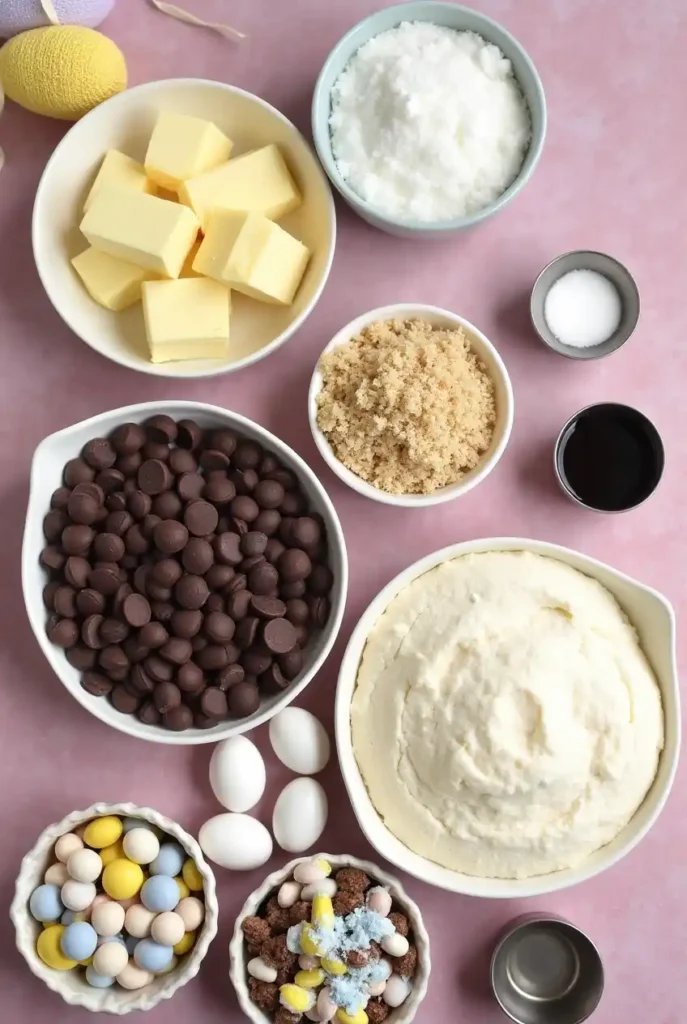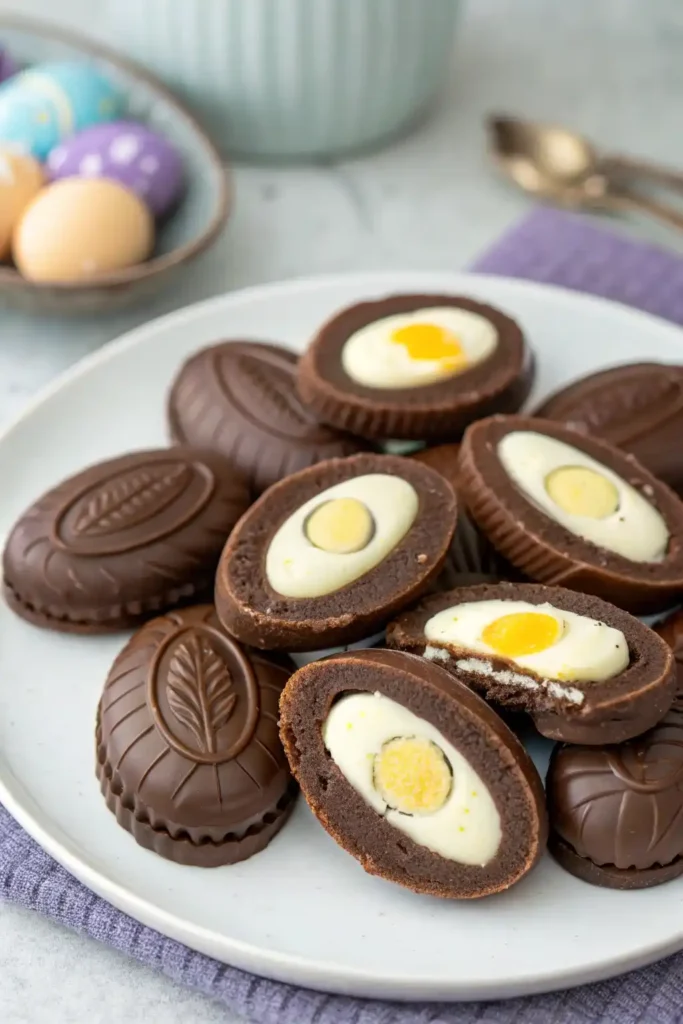Cadbury Mini Eggs have earned their crown as the “queen of Easter candy.”
These beloved treats work magic beyond simple snacking. They transform into irresistible cookies that feature soft, chewy centers and crispy edges. Mini chocolate chips blend perfectly with them to create an ideal chocolate balance in every bite.
We found that these Easter egg cookies stand out as more than seasonal treats. Brown butter adds a rich, nutty flavor to these versatile cookies. The recipe makes 18 generous cookies that stay fresh up to 5 days in proper storage. Your Easter gathering guests will love them, and they make a special treat any time you need something extraordinary.
Let’s take a closer look at creating these delightful treats that bring Easter baking magic to your kitchen!

Table of Contents
Understanding Cadbury Eggs for Baking
Making perfect Easter cookies starts with picking the right Cadbury eggs. Let’s look at the different types you can use and the best ways to add them to your cookies.
Types of Cadbury eggs available
Cadbury makes several egg varieties that each add something special to your cookies:
- Mini Cadbury Eggs – These small, candy-coated milk chocolate eggs come in beautiful pastel colors and feature a hard, crunchy shell with creamy chocolate centers. You can find them in standard pastel colors, rainbow colors, and even dark chocolate varieties.
- Cadbury Creme Eggs – These iconic eggs have a fondant filling that looks just like egg whites and yolks. You’ll find them wrapped individually during Easter season.
- Cadbury Caramel Eggs – These work just like Creme Eggs but have a caramel filling instead of fondant.
- Cadbury Chocolate Creme Eggs – A version that uses chocolate-flavored fondant filling.
- Micro Mini Eggs – The newest and smallest version that you can add straight to cookie dough without crushing.
Why mini Cadbury eggs work best in cookies
Bakers love using mini eggs in their cookies. Here’s what makes them special:
The size-to-crunch ratio hits the sweet spot. Their candy shell creates a perfect textural contrast against soft cookie dough in every bite. These eggs keep their shape while baking, so you get nice chunks of chocolate throughout your cookies.
Those pretty pastel shells make your Easter cookies look amazing. The coating helps the chocolate stay intact during baking instead of melting away completely.
These eggs are super versatile too. You can mix them into your dough or press them on top before baking. This makes them more useful than bigger egg varieties.
How to properly crush Cadbury eggs
The right crushing technique will make your cookies even better. Here are the best methods:
The Bag Method (Recommended)
- Put mini eggs in a heavy-duty ziplock freezer bag
- Push out extra air and seal well
- Take a rolling pin, meat mallet, or heavy pan to gently tap the eggs
- Try to get a mix of bigger chunks and smaller pieces – not powder
Pro tip: Don’t crush them too much – bigger pieces show off the texture and color in your cookies better.
Some people like to chill the eggs before crushing. This helps keep those pretty pastel colors in bigger pieces.
Food Processor Method (Use with caution) The food processor can work, but watch it carefully. Just one or two pulses can turn your eggs into dust. If you try this way, pulse quickly and check often.
Stay away from: Using knives to chop Cadbury mini eggs. The hard shells make them roll around, which isn’t safe.
These tips about Cadbury eggs will help you make amazing Easter cookies that show off these seasonal treats perfectly.
Essential Ingredients for Cadbury Egg Cookies

The secret to amazing Cadbury egg cookies lies in choosing the right ingredients and knowing how they work together. You’ll get cookies with the perfect texture, flavor, and looks that make those pastel mini eggs shine when you nail this combination.
Base cookie ingredients
These basic ingredients are the foundation of any great Cadbury egg cookie recipe:
- All-purpose flour (2¼ to 3⅓ cups): Builds your cookie’s structure
- Granulated sugar (½ to 1 cup): Gives sweetness and crisp texture
- Brown sugar (½ to 1 cup, packed): Makes cookies moist and chewy
- Eggs (1-2): Hold everything together
- Vanilla extract (1-2 teaspoons): Brings out flavor
- Leavening agents: Baking soda (½-1 teaspoon) and/or baking powder (1 teaspoon)
- Salt (¼-½ teaspoon): Balances sweetness and brings out flavors
The way you balance these ingredients shapes your cookie’s final texture. More brown sugar leads to softer, chewier cookies, while extra white sugar creates crispier edges.
Butter vs. shortening debate
Your choice of fat changes your Cadbury egg cookies’ texture and flavor. Bakers often debate between these options:
Butter (100% fat + milk solids and water):
- Gives rich, unique flavor
- Creates flatter cookies as it melts faster during baking
- Makes crisp edges with softer centers
- Needs refrigeration before baking
Shortening (100% hydrogenated vegetable oil):
- Makes softer, fluffier cookies that keep their shape
- Melts at higher temperatures than butter
- Keeps cookies soft longer
- Lacks butter’s rich taste
- Works without refrigeration
Most skilled bakers mix equal parts butter and shortening. This mix gives you butter’s amazing flavor plus shortening’s ability to hold shape. Tests with different ratios show that cookies made with this 50/50 mix, chilled for an hour, look and feel just right.
Flour measurement techniques
Bad flour measurement ruins more cookies than anything else. Too much flour makes dry, cakey cookies; too little makes them spread too much.
Try these reliable methods:
Spoon and Level Method (Recommended):
- Stir the flour with a whisk or spoon
- Add flour to measuring cup until it’s full
- Scrape excess with a knife
- Skip packing or tapping the cup
Scale Method (Most Accurate): A kitchen scale removes all guesswork. Use 120-125 grams per cup of all-purpose flour. This method gives you the same results every time.

Add-ins that work with Cadbury eggs
Cadbury mini eggs steal the show, but these extra ingredients make your cookies even better:
- White chocolate chips: Their smooth sweetness matches the candy shell’s crunch
- Milk or semi-sweet chocolate chips: Add more chocolate flavor
- Toasted coconut: Brings texture and subtle flavor that fits the Easter theme
- Chopped nuts: Walnuts or pecans add nice crunch
A sprinkle of sea salt right after baking creates an amazing sweet-salty mix that makes the chocolate taste even better.
The best Cadbury egg cookies need just the right mix of structure, sweetness, and texture to show off those colorful eggs. Once you know what each ingredient does, you’ll make Easter treats that vanish from the cookie jar quickly.
Step-by-Step Cadbury Egg Cookie Recipe
Let’s make these delectable Cadbury egg cookies now that our ingredients are ready. A methodical approach will give these Easter treats perfect results every time.
Preparing your workspace and tools
The oven needs to be at 350°F (180°C) before you start working with the dough. Your baking sheets should have parchment paper or silicone baking mats to prevent sticking and make cleanup easier.
You’ll need these tools:
- Mixing bowls (separate ones for wet and dry ingredients)
- Stand mixer or electric hand mixer
- Measuring cups and spoons (or kitchen scale for precision)
- Rubber spatula for folding
- Cookie scoop for uniform cookies
Make room on your countertop for these items and crushing your Cadbury eggs.
Mixing the perfect cookie dough
Start by creaming your fat (butter, shortening, or combination) with both sugars until light and fluffy. This usually takes 3-4 minutes. Add the eggs and vanilla extract and beat for another 3-4 minutes until the mixture becomes pale and creamy.
Whisk your dry ingredients (flour, baking soda, baking powder, and salt) in another bowl. Add this mixture slowly to your wet ingredients and mix on low speed until just combined. Your cookies will become tough if you mix too much at this stage.
Adding Cadbury eggs without overmixing

Your dough needs the crushed Cadbury mini eggs folded in gently. Save about ¼ cup of crushed eggs to press on top of the cookies before baking – this creates an appealing look.
A rubber spatula or wooden spoon works best here. Use gentle strokes to distribute the eggs evenly. This keeps your dough’s texture perfect and protects those colorful candy pieces.
Proper baking techniques
Roll the dough into balls (about 1½-2 tablespoons each) and place them on your prepared sheets. Leave 2-3 inches between each ball. Press some of your saved Cadbury egg pieces on top of each dough ball.
The cookies should bake for 10-12 minutes. Look for slightly golden brown edges while centers appear a bit underbaked. This creates that perfect mix of crispy edges and soft, chewy centers that makes these cookies impossible to resist.
The cookies need 5 minutes to cool on the baking sheet before moving them to a wire rack. A sprinkle of flaky sea salt during this time will lift the flavor profile and balance the sweetness perfectly.
Troubleshooting Common Baking Issues
Baking Cadbury egg cookies can be tricky, even for seasoned bakers. Let’s explore common problems and their solutions to help you make perfect Easter treats.
Fixing cookies that spread too much
Your mini Cadbury egg cookies might turn out flat and spread out due to several reasons. The butter temperature plays a key role here. Butter that’s too soft or slightly melted often causes excessive spreading. The ideal butter should just dent with a finger press – not warm or losing its shape.
The cookie dough temperature also affects spreading. You should refrigerate your dough balls at least 30 minutes before baking. Keep unused dough in the fridge between batches.
Problems with measurements could be the root cause. Cookies without enough flour lack the structure to hold shape. The solution is simple – add 1-2 tablespoons more flour to your remaining dough if you notice excessive spreading.
Solving overly dry or crumbly dough
A dry, crumbly Cadbury egg cookie dough usually points to flour measurement issues. The dough won’t bind properly if flour gets packed too densely in measuring cups.
The right way to measure flour makes a difference. You should whisk it first to add air, then spoon it into measuring cups and level with a knife – never pack it down. In spite of that, you can still fix crumbly dough by adding moisture.
A splash of milk (1-2 tablespoons) helps restore the right texture. The flour-to-fat ratio is also worth checking. Sometimes 2-4 tablespoons of softened butter can save overly dry cookie dough.
Preventing Cadbury eggs from burning
The sugar-based candy shells of Cadbury mini eggs burn easily during baking. Place your oven rack in the middle – this ensures heat spreads evenly throughout.
Timing is a vital part of baking Cadbury egg cookies. These cookies are ready when their edges turn golden brown but centers stay slightly soft – usually 8-10 minutes at 375°F. Note that cookies keep baking from leftover heat after coming out of the oven, so slightly underbaked is better than burnt.
The candy coating needs extra protection if it starts to brown too quickly. A loose cover of aluminum foil during the final baking minutes lets the cookie base finish cooking while protecting the Cadbury eggs.
Storing and Serving Your Easter Egg Cookies
Your Cadbury egg cookies need proper storage to keep their amazing flavor and texture. These colorful Easter treats need extra care to taste just as good days after you bake them.
Keeping cookies fresh for days
Room temperature storage in an airtight container works best for your Cadbury egg cookies, keeping them fresh up to 5 days. Here’s a baker’s secret for soft, chewy cookies: add a white bread slice or some marshmallows to your container. These items release moisture slowly and create humidity that keeps your cookies soft.
Tests of different storage methods showed that containers with marshmallows kept cookies remarkably fresh, scoring 7/10 for texture and flavor. The marshmallows become firm while cookies stay chewy in the middle with crisp edges, without any flavor changes.
Royal icing decorations on Easter egg cookies need about 2 hours to set before storage. The icing creates a protective barrier that helps decorated cookies stay fresh longer than plain ones.
Freezing options for dough and baked cookies
Freezing stands out as the best way to store cookies long-term. Cookies that were frozen then thawed scored a perfect 10/10 in freshness tests. Your Cadbury egg cookies freeze well if you:
- Allow cookies to cool completely
- Layer them between sheets of parchment paper
- Place in freezer-safe containers or ziplock bags
- Freeze for up to 3 months
You can also freeze unbaked dough to enjoy fresh-baked cookies anytime. Roll the dough into balls, freeze them on a baking sheet until solid, then move them to freezer bags. Add 1-2 minutes to your usual baking time when you’re ready to bake.

Best serving temperature
Tests show that frozen cookies should thaw in their sealed container at room temperature until they feel warm to touch. This keeps moisture away and preserves their texture.
Warm cookies slightly before serving for the ultimate Cadbury egg cookie experience. A quick 5-10 seconds in the microwave brings back that fresh-baked taste with melted chocolate chunks – while the Cadbury shell stays delightfully crunchy.
Conclusion
Cadbury egg cookies make the perfect Easter treats. These delightful creations feature soft, chewy centers and crispy edges that showcase beautiful pastel mini eggs. Your cookies will turn out perfectly each time with the right ingredients, precise measurements, and proper preparation steps.
The magic happens when you nail the details. Getting the butter-to-shortening ratio right and crushing those colorful mini eggs just enough makes all the difference. These treats stay fresh up to 5 days when stored properly, and you can freeze them to enjoy well beyond the Easter season.
Our troubleshooting guide helps you tackle any baking challenges that might pop up. You’ll find more Easter baking ideas and delicious recipes at recipesnutritious.com. These techniques and tips will help you create irresistible Cadbury egg cookies that your family will cherish as part of their Easter traditions.
FAQs
Q1. How do Cadbury Mini Eggs affect cookie texture? Cadbury Mini Eggs add a delightful crunch and texture contrast to cookies. Their candy shell provides a satisfying bite while maintaining integrity during baking, creating pockets of chocolate throughout the cookie.
Q2. What’s the best way to incorporate Cadbury eggs into cookie dough? Gently fold crushed Cadbury Mini Eggs into the cookie dough using a rubber spatula or wooden spoon. This method preserves the dough’s texture and the integrity of the colorful candy pieces. Reserve some crushed eggs to press onto the cookie tops before baking for visual appeal.
Q3. How can I prevent my Cadbury egg cookies from spreading too much? To prevent excessive spreading, ensure your butter is at the right temperature (soft enough to dent, but not melted), chill the dough before baking, and make sure you’re using the correct amount of flour. If needed, add 1-2 tablespoons more flour to the remaining dough.
Q4. What’s the ideal baking time for Cadbury egg cookies? Bake Cadbury egg cookies for 10-12 minutes at 350°F (180°C), or until the edges are slightly golden brown while centers still appear slightly underbaked. This creates the perfect balance between crispy edges and soft, chewy centers.
Q5. How long do Cadbury egg cookies stay fresh? When stored in an airtight container at room temperature, Cadbury egg cookies maintain their quality for up to 5 days. For longer storage, you can freeze baked cookies for up to 3 months or freeze portioned dough balls to bake fresh cookies whenever desired.

